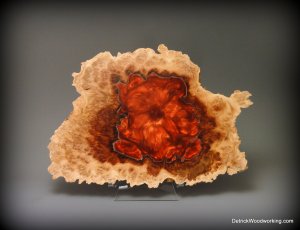I have been doing quite a bit of Alumilite casting lately and this is my latest. This started out as a slice of Australian Red Mallee burl where termites had eaten away the the center portion of the burl. I used this opportunity to fill the void with a copper colored Alumilite. While I was at it I swirled a flower design into the Alumilite before it cured... yup, on purpose  Sometimes it's better to be lucky than good!
Sometimes it's better to be lucky than good!
Edit: You need to click on the picture to enlarge it to see the detail.

Edit: You need to click on the picture to enlarge it to see the detail.

Last edited:
